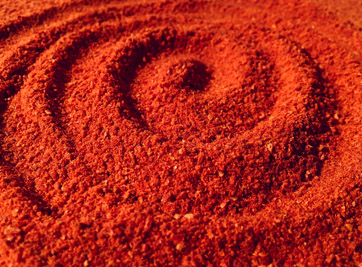
Identifiers
INS No 160c(i); Paprika oleoresin
INS No 160c(ii); Paprika extract
E160c; Paprika extract, capsanthin, capsorubin
Physical Description
Paprika is the ground dried pod of mild capsicum (Capsicum annuum L.). Paprika oleoresin is the combination of flavor and color principles obtained from paprika (Capsicum annuum L.) by solvent extraction. The the major coloring principles are capsanthin and capsorubin; a wide variety of other colored compounds are known to be present. Paprika extract is obtained by solvent extraction of the dried ground fruit pods of Capsicum annum. The major coloring principle is capsanthin. Other colored compounds, such as capsorubin, canthaxanthin, cryptoxanthin, zeaxanthin and lutein, as well as other carotenoids are also present. The balance of the extracted materials is lipidic in nature and varies depending on the primary extraction solvent.
Common Uses
Paprika is used to color meat products, confectionery, vegetable oils, snacks, surimi, seasonings, soups, sauces, salad dressings, marinades, processed cheese, bakery products, fruit preparations, convenient foods and canned goods.
Specifications
JECFA
US FDA
Commission Regulation (EU) No 231/2012
Codex GSFA Provisions
Paprika extract (INS No 160c(ii)) is added to foods and beverages at concentrations up to a maximum permitted level (MPL) as established by the Codex Alimentarius Commission. There are currently 3 food categories for which MPLs for paprika extract have been adopted in the General Standard of Food Additives. Many other applications of paprika extract as a color additive in foods and beverages have been proposed and are pending adoption, following completion of the review and comments process.
Regulatory Approvals
Safety Reviews
Evaluation of certain food additives (Seventy-ninth report of the Joint FAO/WHO Expert Committee on Food Additives) WHO technical report series no. 990, 2014. Available online
Evaluation of certain food additives and contaminants (55th report of the JECFA) WHO Technical Report Series No. 901, 2001. Available online
Toxicological Evaluation of Some Extraction Solvents and Certain Other Substances (14th report of the JECFA) FAO Nutrition Meetings Report Series No. 48A, 1970. Available online
EFSA ANS Panel (EFSA Panel on Food Additives and Nutrient Sources added to Food), 2015. Scientific Opinion on the re-evaluation of paprika extract (E 160c) as a food additive. EFSA Journal 2015;13(12):4320, 51 pp. Available online